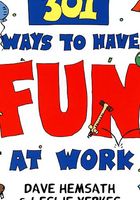
INTRODUCTION

Fun at work—is it an oxymoron or the newest business management trend?
We believe that fun at work may be the single most important trait of a highly effective and successful organization; we see a direct link between fun at work and employee creativity, productivity, morale, satisfaction, and retention, as well as customer service and many other factors that determine business success.
We wanted to help people see that link, so we decided to conduct an international survey to collect real and relevant stories of what actual businesspeople are doing to create fun workplaces. The results have been phenomenal. We received responses from individuals at many levels of the corporate hierarchy, who work within companies of all sizes and in a wide variety of industries. The responses revealed that many successful companies have made fun an integral part of their corporate culture. Fun has become an organizational strategy—a strategic weapon to achieve extraordinary results in areas of corporate life ranging from training sessions to meetings to hiring practices.
Humor consultant and bestselling author C. W. Metcalf wrote in HR Focus (February 1993) that “humor is a vital, critical element for human survival, and we often forget about it, and set it aside. We are told that laughter, fun, and play are unadult, unintelligent, and nonprofessional. Nothing could be further from the truth. One of the first indicators of the onset of most mental illness is a loss of the sense of joy in being alive.”
Fun and humor help individuals through crisis and change. Because they facilitate the release of tension, fun and humor increase employees’ ability to cope with stress on the job and to remain flexible, creative, and innovative under pressure—central features of a strong, resilient corporate culture.
Organizations that integrate fun into work have lower levels of absenteeism, greater job satisfaction, increased productivity, and less downtime. As cited in HR Focus in February 1993:
In the nine months that followed a workshop conducted by C. W. Metcalf at Digital Equipment Corporation in Colorado Springs, twenty middle managers increased their productivity by 15 percent and reduced their sick days by half.
Employees from the Colorado Health Sciences Center in Denver who viewed humorous training films and attended fun workshops showed a 25 percent decrease in downtime and a 60 percent increase in job satisfaction.
Fun and the energy it creates are contagious. By far, the most intriguing part of the hundreds of surveys we received are the many stories of the ways that individuals and companies incorporate fun into the workplace.
This book is essentially a compilation of these fun and inspiring stories.